Michael's Long Box - Full Metal Fiction #1 (1997, London Night Studios)
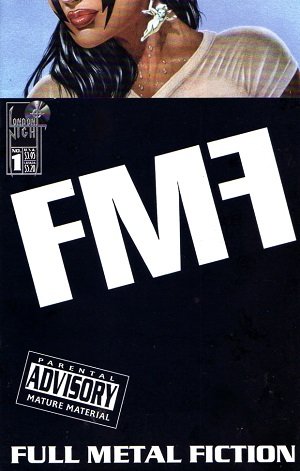
Note: there are a lot of images in this article, so to avoid making the same statement over and over, note that unless I specifically source it from somewhere else, every picture in this entry was scanned by me, but is (c) 1997 London Night Studios.
Been a while since I threw a bone to my comic-junkie buddies. Since I'm still in the process of pulling, reading, and researching for my big Razor project, I figured I'd look at one of the side pieces to my collection of London Night stuff.
Full Metal Fiction was to London Night what Dark Horse Presents was to Dark Horse comics: a black-and-white anthology series where each issue contained multiple short stories. These shorts were usually multi-part pieces, continued in subsequent issues, sometimes relying on knowledge of previous books for character introductions, sometimes spinning off into their own dedicated comic issues for their conclusion, but the occasional one-shot story also surfaces. Without further ado, this here's Full Metal Fiction #1 with a large 3/4 wrap to censor Stephen Sandoval's cover for NSFW-reasons we'll be delving into shortly.
Full Metal Fiction as a title didn't last very long. Whether due to an erratic publication schedule, a slump in sales due to the late-90's crash, or a combination of these or other factors, the series only managed eight total issues before its cancellation. Despite this, every issue was chock full of London Night Studios' standards for gratuitous nudity, amputations, bloodletting, and vigilante violence, along with other 90's norms including reprints and variant covers. All of this ensured that if you wanted a complete collection of FMF (and why wouldn't you, unless you were some sort of filthy casual reader?), you'd need to add eleven books to your long box. And at $3.95 a shot, that was forty-four bucks plus tax gone from your retirement savings.
Nobody ever said fandom came cheap.
If you come across it in the wild, Issue 1 of Full Metal Fiction from March of 1997 comes in three flavors. The first is the one used for the thumbnail of this very article. Here's the full-sized experience in case the opening teaser didn't quite do it for you:
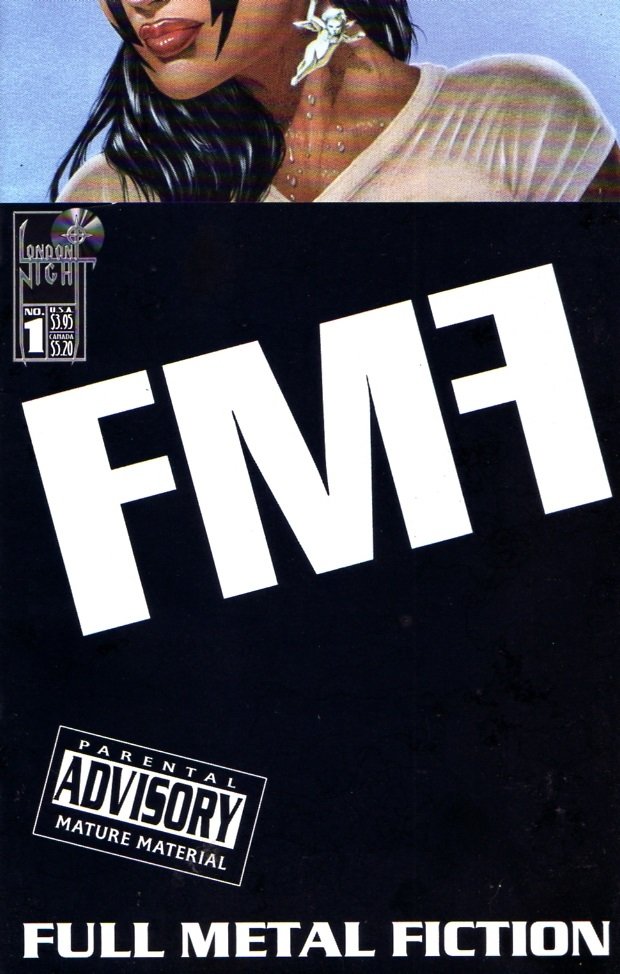
It's hard to tell with the wrap, but that's Razor participating in a wet t-shirt contest, because nothing says 'dark-hearted psycho vigilante who suffered a traumatic childhood of violence and sexual abuse' like a picture of that grown woman joining a shoot for Girls Gone Wild.
Philosophical Aside: if an issue #1 was released in the 90's and it didn't have a variant cover option, did it actually go to print? Publisher Everette Hartsoe must not have thought so -- here's the alternate cover you might stumble across while ransacking back-issue bins:
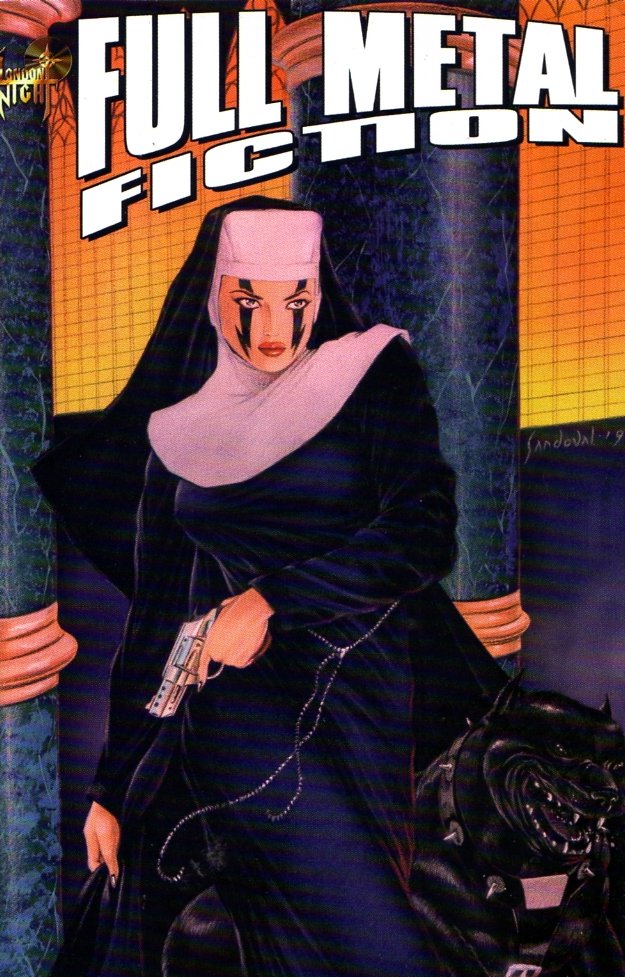
I know it's cheesy as hell, but I actually dig this 'nun with a gun' pulpy cover. Given Razor occasionally crossed paths and/or blades with Ben Dunn's Warrior Nun Areala, this seems an oddly appropriate tribute from Stephen Sandoval. It's certainly classier than his "Miss Spring Break" edition above.
Demand for issue 1 outstripped supply initially, so London Night authorized a second printing five months later which is almost, but not quite, exactly like the first printing. Here, let's see if you can tell the difference:
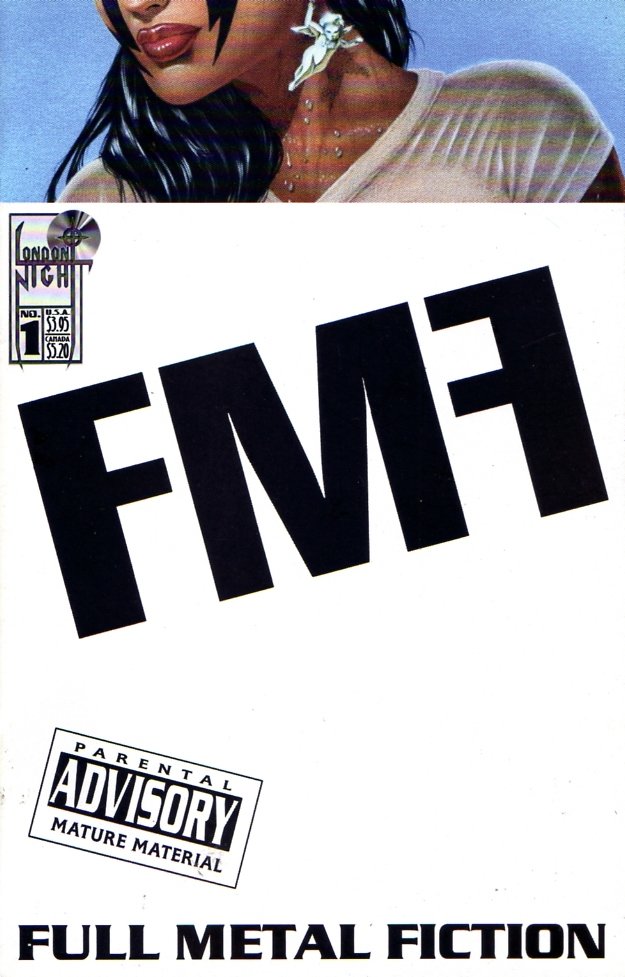
Holy crap, do I need to clean my scanner. Sorry 'bout that. In any case, if the difference eludes you or the cover wrap is missing for some reason, it's identified as the August 1997 2nd Printing on the bottom of the inside cover. Do not be fooled! Accept only legitimate first printings purchased from reputable Steemians like @cryplectibles. :D
Kidding aside, let's dive in and take a look at FMF's guts. What's there, why might you (not) want to buy it, and why should you even care?
What's Inside
Full Metal Fiction #1 features four different stories entangled within its 48 pages. None of the stories or content changes between the first and second printings, so there's not really any need to own more than one copy unless you're a total dork like me.
First, from writer Everette Hartsoe and artist Stephen Sandoval, comes Razor: Year One. Ripping a page from Frank Miller's treatment of that other darkness-stalking vigilante, Hartsoe takes us back to the days when Nicole Mitchell first strapped on the blades, donned the Crow-inspired makeup, and became Queen City's unofficial protector.
Errr...or does he? The Detective's opening monologue dates the story to June 6th, 1997, and the narrative text blocks linking that discovery to Razor's attack on the gang make it clear this is the same place. Razor's monologue as she hurls herself into the fray gives her birth date as May 24th of 1970 and states she took up the name 'Razor' eighteen years later. Nicole would be 18 years old in 1988, but if this story does take place in '97, that means Razor just celebrated her twenty-seventh birthday. Seems like Razor's "year one" should happen in '88 or '89, but even that's suspect since in Razor #3 Hartsoe wrote her birth date as May 24th, 1968...
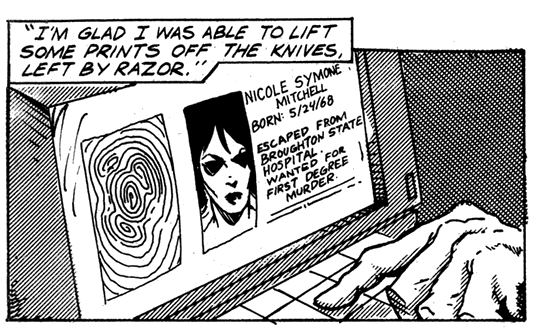
Assuming the police computers are accurate, that would have Razor pushing thirty in this story.
See kids, this is why 'continuity' is the biggest nightmare on the planet. Why the hell do I do this to myself...?
It's only 8 pages, which is a bit disappointing since Razor at this point is London Night's star attraction, but the purpose of Full Metal Fiction as far as I can gather, isn't to showcase their lead but use her to introduce other people's books and characters. By this metric it gets the job done, but there's not a lot that happens here: the cops, including Detective Andy Stanich, break into an apartment where a morbidly obese guy's been hung from the neck, cut in half, disemboweled, and emasculated (his guy bits, the apartment manager helpfully points out, were left in a nearby jar). Tenants were complaining about the smell.

Here's a picture of a puppy, because nobody should read a sentence like that and continue on without therapy. Source: Pixabay
From there, we move to a gang meeting disrupted when Razor dives in through the skylight and starts hacking off limbs:
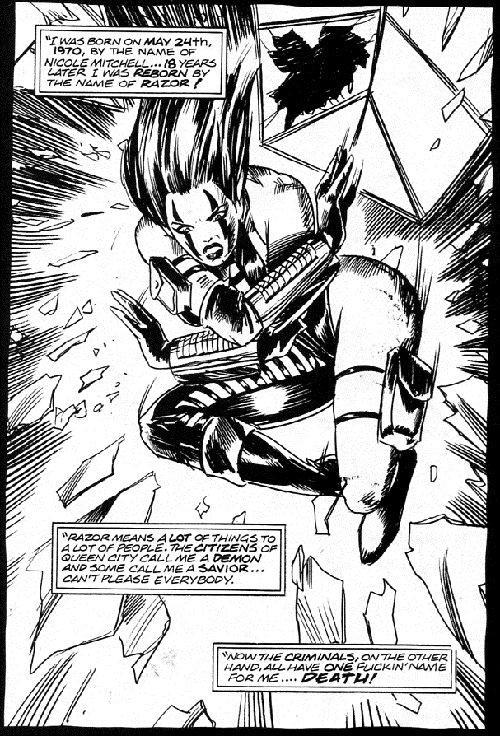
The story ends on a cliffhanger when a gangbanger who used one of his own homies for cover pulls a pistol on Razor, claiming her ass is his. Next issue we'll presumably watch Razor feed this guy his own stomach, but for now we segue to the next segment: writer David Quinn and artist Shelby Robertson's Arizona: The Wild.
Arizona's a shape-shifting duidess of sorts, just trying to get her nature commune on in Queen City Park, but when she steps in to mediate a dispute between a woman and the asshole who feels he's entitled to get in her pants after providing dinner and a movie, all hell breaks loose. Attacked by a more powerful shapeshifter called Kreature, Arizona is taken captive by Hellbent, a group using Arizona to coax her teammates to come to her rescue. Note that Arizona's part of a group called "Hellborne". Can we please get some other prefix for our hero and villain squads?
There's a lot going on in this ten-page partial story, and if you don't know your London Night stuff, you'll be utterly lost even though Quinn tries to shoehorn in all the information you need. It doesn't help that the story bears neither an opening page or a closing one, making me think this was originally intended for a full-size issue and was quickly chopped down to size for inclusion here. The reader really needs to be familiar with the Knight Shift, Morbid Angel and Poizon books to get the full value from this excerpt. Robertson's artwork is dark, busy, and often oddly-framed, making it difficult to get a sense of what's happening on the page:
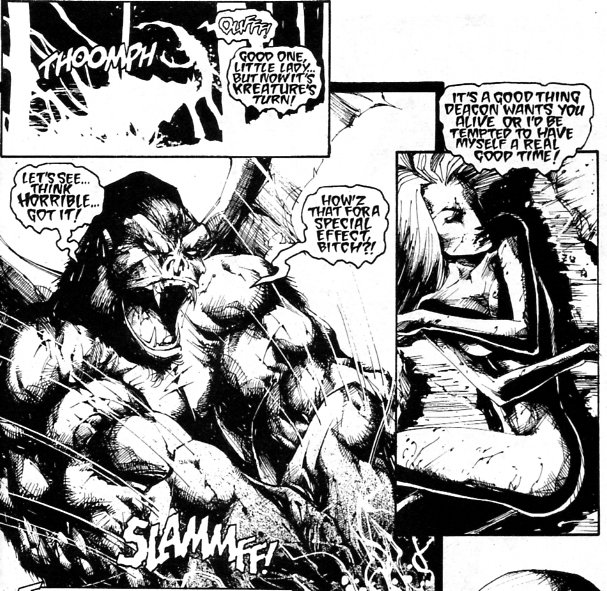
Hellborne get to the place they've been directed to go to save Arizona, Morbid Angel and Shadow Viper get brief introductions, and then without warning we slip into Killing Machine, written by S.D. Lester and drawn by P.D. Peterson.
At twelve pages, it's the longest story in the anthology. It's also self-contained, which should be a good thing, but it leaves an awful lot of questions after it ends, so this is one I feel should have a sequel somewhere.
Killing Machine is the story of a Terminator and his teddy bear. It's very matter-of-fact, with the story told entirely through the titular character's bizarre, erratic and random thoughts. Machine can't keep his mind off of killing for very long -- what little is left of his original brain is the part dedicated to violence, and though we don't learn the hows or whys, that brain has been housed into a metallic body that is part endoskeleton and part slaughterhouse.
Machine has one friend in all the world: his teddy bear. Bear keeps him steady, gives him companionship he cannot get from any other living being (since his only thoughts are to destroy everything else), and never judges him since, you know, it's a stuffed animal. We don't know where Bear came from, just that Machine loves Bear, but he cannot love Bear more than he loves killing.
Unfortunately, a group of redneck hunters are about to find out just how much Machine hates humanity when they go after him. It's understandable, since Machine just gunned down one of their own children (the kid had found Machine's bear, and Machine was unable to stop himself from killing the child), but still a shame.
Peterson's artwork is lean and sparse, a sharp contrast to Robertson's work, making it easy to recognize where one ends and the other begins. It has a very Sin City vibe to it, in my opinion:
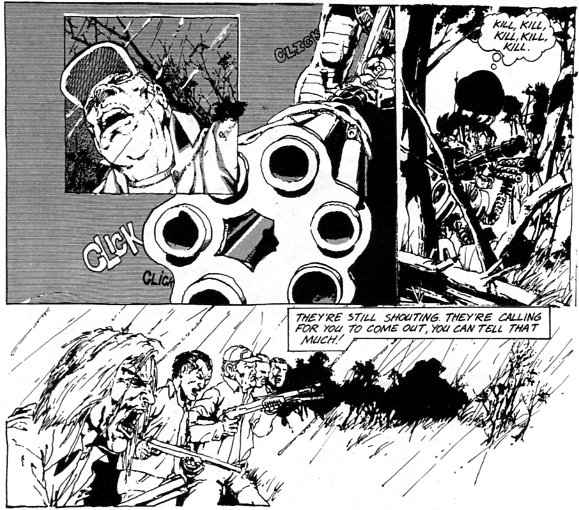
Again, there's not much to this: group of hunters stalk killing machine who turns them into hamburger, saving the nastiest execution of all for the one who inadvertently shoots his bear. An interesting concept, and one I wish had room for expansion as there's plenty of questions raised and no good answers provided. But alas, Machine departs with his newly-patched Bear, and we turn the page to encounter Sade, written by Kevin Hill, and drawn by Scott Pentzer.
The final entry in the book is kind enough to point out that Sade's origin is printed elsewhere, and to contact your local comic shop for back issues. Much like the Arizona story from before, I'm familiar with Sade as a character, but not her overall arc, what she stands for, and why she does what she does.
This story doesn't do much to correct that. Sade's presented as a sort of ghostly presence, a woman who can get into anywhere and find anyone. She uses these powers to direct others to do her bidding, and in this story, there's not a lot going on. She first appears to a police detective, telling him to take care of the leaks within his department. We then flash back to "The Past", where we see the assassination of a pair of political figures running for governor and lieutenant governor. Witness to the carnage is a young boy whose father, the driver of the car in which the would-be governor was travelling, is gunned down as well:
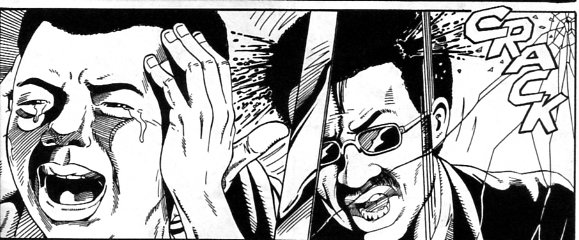
Fast forward to the present, and Sade has dropped in on this boy, Jacob Henry Jackson, now all grown up, saying she's been looking for him. She directs him to go to a particular subway stop and wait there for further instructions, where he's then given the assignment of boarding the train, tailing a particular passenger, and taking note of everything he does and anyone he talks to. No further information is forthcoming, either to Jackson or to the readers, because this is where the story ends, promising a continuation in the next issue with special guests Rose and Gunn, and hyping the new Sade monthly comic starting later in the year.
I can see why Full Metal Fiction didn't last very long. The stories are truly a mixed bag in this first issue. Razor's always fun to see in action, and I enjoyed Killing Machine for what it is even though I wish there was more of it. The Arizona and Sade stories, however, didn't give me much reason to care about the characters, and presumed too much familiarity on the reader's part. There is some interesting stuff in each of those stories: Arizona sets up a supernatural smackdown in the middle of an abandoned mental asylum, while Sade is playing a long game around political assassinations, but my curiosity is piqued because I know a little about these characters already. Someone going in blind isn't likely to be persuaded to continue without a good reason.
Maybe Hartsoe and Sandoval suspected something like this going in though. How do you drive enough demand for a second printing? Remember what I said about using that flap to censor Sandoval's cover back at the beginning? Well, this is what's underneath it:
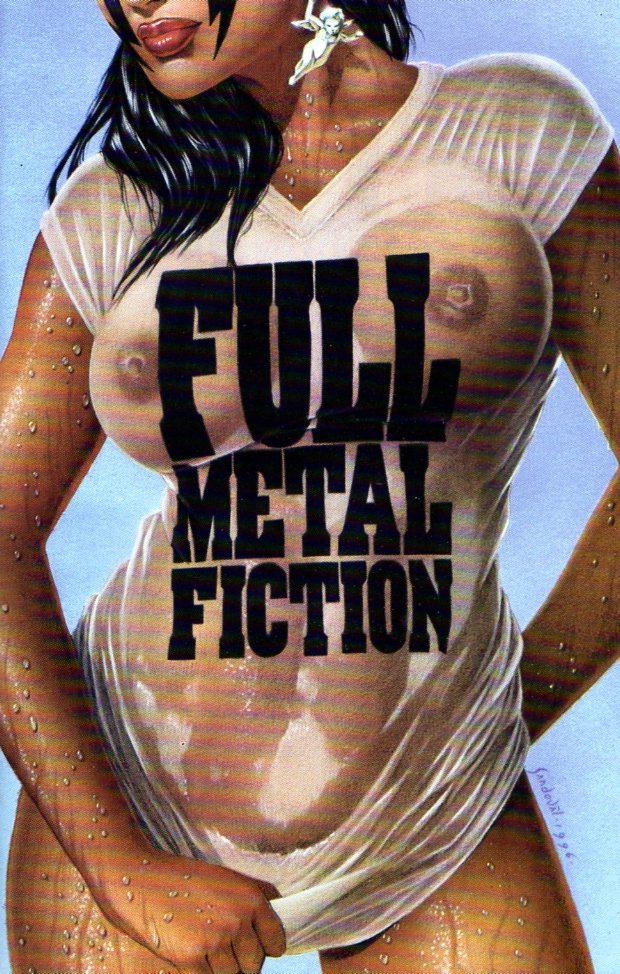
With this, I both earn a #NSFW tag, and inspire @peekbit's next pose. :D
Of course it sold through its first print run.
Did you enjoy this rundown/recap? Would you like to see more Full Metal Fiction in the future? If so, let me know in the comments, upvote and resteem! Otherwise you're at my mercy for what I write about next. Thanks for slogging through with me, and I'll see you next time I dare to dive into Michael's Long Box!